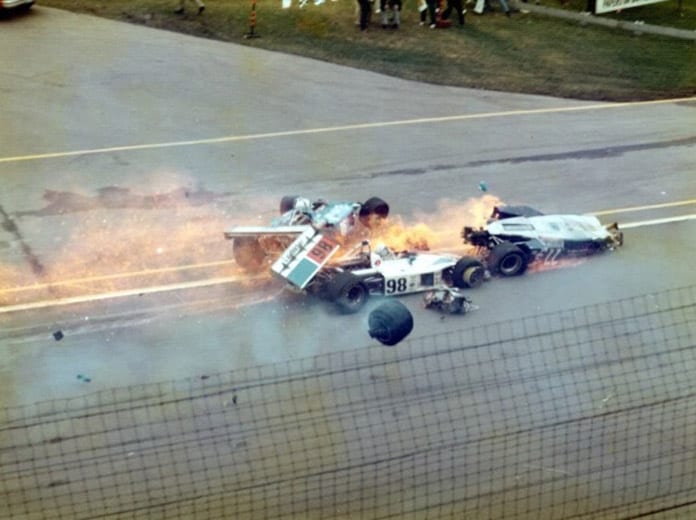
Meanwhile, some sense was trying to be made of what had transpired. A.J. Foyt said, “I don’t know exactly what happened. Salt wasn’t accelerating very well. When he went into another car, I scrunched down in my seat and stood on it. I wanted to get the hell outta that mess.”
Although no blame was assigned, most agreed that drivers urgently trying to improve their positions, anticipating a rain-shortened race, contributed. “I looked ahead and saw four cars abreast,” exclaimed Wally Dallenbach. “It was a lousy start…”
During a drivers’ meeting the following morning, one driver angrily shouted, “If you don’t shape up the start, you’re going to get us all killed out there.” The meeting broke into an obscenity-laced shouting match. Later, Foyt, Peter Revson and Steve Krisiloff were fined for improving their positions before the green flag.
Tuesday, May 29, came and went with no race as it rained again.
By Wednesday morning, nerves were on a ragged edge. The long waits, the tragedy and uncertainty knocked even normally cool, collected drivers off kilter. Then it rained. The festive atmosphere of Indianapolis dissolved into a rain-soaked, oppressive bleakness.
Almost unexpectedly, at 2:10 p.m., the track was deemed dry enough to start. Few expected the race to go 500 miles.
Exorcising three days of pent up adrenaline and pushing to get to the front before it rained again, drivers put on an exciting and aggressive show. There was much passing and three-wide racing with Johncock, Bobby Unser, Al Unser and Savage swapping the lead throughout the late afternoon.
The race seemed to have settled into a routine when suddenly, on lap 58, Savage, running in second place, lost control of his STP Eagle in turn four. It slammed the inside wall with such force that it literally exploded into hundreds of pieces.
The transaxle and engine bounded down the track, tearing chunks out of the pavement. The cockpit section flipped and ground across the track, smacking the outer wall and bursting into flames.
Savage remained conscious through the entire ordeal, even radioing his crew from his mangled car, “Holy Christ, what a mess!”
As emergency workers struggled to extinguish the flames and extricate Savage, a fire truck rushing to the scene, traveling in the opposite direction up pit road, struck Savage team member, Armando Teran. The 23-year-old died instantly.
Savage was transported to Methodist Hospital and was expected to live. But the tentacles of this evil month wouldn’t let go. Savage died on July 2 and the actual cause of his death is still debated today.
For the second time, the race was red flagged for an accident. When it resumed an hour later, minor incidents and mechanical failures eliminated car after car until by the 120th lap only 11 were running.
On the 129th lap, rain came again and on the 133rd the race was red flagged again. Drivers parked and climbed wearily out of their machines. They waited for a restart that no one really wanted.
They got their wish as the race was declared over. Winner Johncock walked to victory lane. There was little celebration, but Johncock managed a couple of subdued smiles. In lieu of the traditional victory banquet, he visited Savage, his teammate, in the hospital and ate at a Burger Chef.
Johncock’s 1973 victory hung over him like a black cloud. His 500 crown was dissatisfying until his dramatic 1982 triumph over Rick Mears shoved the memory of the 1973 debacle aside.
The curse of the most forgettable 500 had finally run its course.
